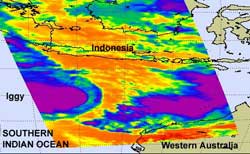NASA Infrared Satellite Instrument Sees Tropical Storm Iggy Growing in Strength

When NASA's Aqua satellite passed over Cyclone Iggy (left) on January 26 at 611 UTC (1:11 a.m. EST) the AIRS instrument measured the cloud (purple) top temperatures. Thunderstorm cloud tops around the entire center of circulation were colder than -63 Fahrenheit (-52.7 Celsius) indicating strong storms. The purple area to the far right is from clouds and showers associated with a low pressure area south-southwest of Darwin, Australia. Credit: NASA/JPL, Ed Olsen <br>
The Atmospheric Infrared Sounder (AIRS) instrument provided an infrared snapshot of Iggy's cloud top temperatures on January 26, 2012 at 0611 UTC (1:11 a.m. EST). The AIRS image showed a large and rounded area of high, cold clouds, around the entire center of circulation.
The data also showed that strongest convection (rapidly rising air that condenses and forms the thunderstorms that make up the cyclone) is located slightly to the west of the center, because of easterly wind shear. The temperatures of those high cloud tops were colder than -63 Fahrenheit (-51.7 Celsius), which is a threshold scientists use to identify strong thunderstorms with heavy rainfall. This is an indication that Iggy will continue to strengthen.
The AIRS image also showed clouds to the southeast of Iggy that are associated with another low pressure area. That area of disturbed weather is over land and located south-southwest of Darwin.
Iggy is currently located in the Southern Indian Ocean, northwest of Western Australia. At 1500 UTC (10 a.m. EST), Tropical Cyclone Iggy was about 430 nautical miles (~495 miles/~796 km) northwest of Learmonth, Australia, near 16.8 South and 109.0 East. It was moving slowly to the southeast at 5 knots (~6 mph/~9 kph). Iggy's maximum sustained winds are near 45 knots (~52 mph/~83 kph) and it is classified as a tropical storm. Those tropical-storm-force winds extend out to 110 miles (177 km) from the center.
Iggy's approach has prompted the Australian Bureau of Meteorology to issue a cyclone and flood watch. Iggy is moving toward the Pilbara coast. The coastal communities between Whim Creek and Coral Bay will likely experience gusty winds and heavy rainfall on January 27 and 28. Rough surf is also expected along coastal areas including Christmas Island, the Kimberley and Pilbara coasts.
Iggy is forecast to continue strengthening as it moves southeast toward Western Australia. Sea surface temperatures along track are 28 to 29 degrees Celsius (~82 to ~84 Fahrenheit), which the Joint Typhoon Warning Center says is supportive of further development. It is expected to reach cyclone strength before moving to the south.
Text Credit: Rob Gutro
NASA's Goddard Space Flight Center, Greenbelt, Md.
Media Contact
All latest news from the category: Earth Sciences
Earth Sciences (also referred to as Geosciences), which deals with basic issues surrounding our planet, plays a vital role in the area of energy and raw materials supply.
Earth Sciences comprises subjects such as geology, geography, geological informatics, paleontology, mineralogy, petrography, crystallography, geophysics, geodesy, glaciology, cartography, photogrammetry, meteorology and seismology, early-warning systems, earthquake research and polar research.
Newest articles

Silicon Carbide Innovation Alliance to drive industrial-scale semiconductor work
Known for its ability to withstand extreme environments and high voltages, silicon carbide (SiC) is a semiconducting material made up of silicon and carbon atoms arranged into crystals that is…

New SPECT/CT technique shows impressive biomarker identification
…offers increased access for prostate cancer patients. A novel SPECT/CT acquisition method can accurately detect radiopharmaceutical biodistribution in a convenient manner for prostate cancer patients, opening the door for more…

How 3D printers can give robots a soft touch
Soft skin coverings and touch sensors have emerged as a promising feature for robots that are both safer and more intuitive for human interaction, but they are expensive and difficult…




















